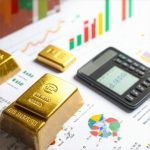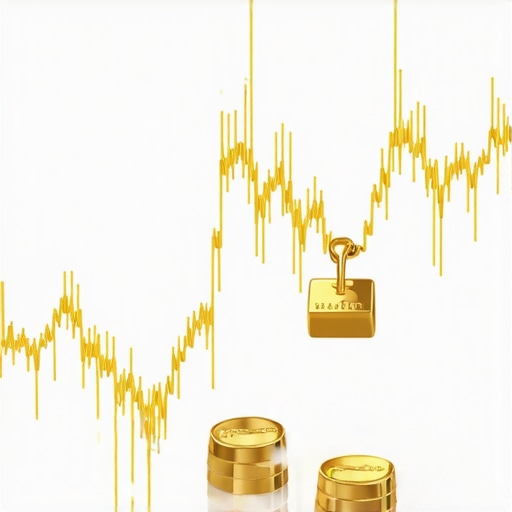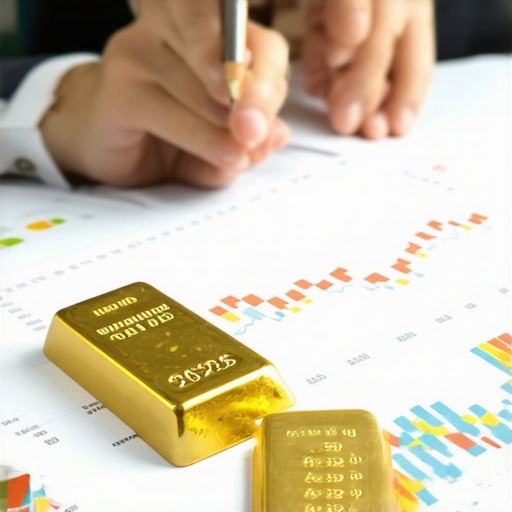Understanding the Nexus Between Gold Demand and Price Movements in 2025
As an industry analyst with decades of experience in precious metals markets, I recognize that the intricate interplay between jewelry consumption and industrial applications profoundly influences gold prices. The year 2025 presents a unique confluence of economic, technological, and sociopolitical factors that will shape demand patterns and, consequently, price trajectories.
Deciphering Jewelry Demand: Luxury Trends and Cultural Shifts
The global demand for gold in jewelry remains a cornerstone of market stability, accounting for approximately 50% of annual consumption. Emerging markets, particularly in Asia, continue to drive consumption driven by rising disposable incomes and shifting cultural norms around adornment. However, fluctuations in consumer confidence and fashion trends can introduce volatility, especially if sustainability concerns prompt a re-evaluation of gold sourcing practices.
Industrial Gold Demand: Technological Innovation and Green Energy
In the industrial sector, gold’s excellent conductivity and corrosion resistance make it indispensable in electronics, aerospace, and renewable energy sectors. The proliferation of 5G technology, electric vehicles, and green energy initiatives signal a burgeoning industrial demand. Yet, supply chain disruptions and technological shifts could either amplify or temper this demand surge, impacting prices accordingly.
How Will Manufacturing Advances and Supply Chain Resilience Affect Gold Prices in 2025?
Experts debate whether technological innovation will lead to increased efficiency or create new demand channels for gold, especially as alternative materials become viable. Additionally, geopolitical tensions and mining restrictions may constrain supply, exerting upward pressure on prices. For investors, understanding these dynamics requires analyzing supply-demand elasticity and geopolitical risk assessments.
Central Bank Policies and Market Sentiment
Central banks’ gold reserve management strategies significantly influence market sentiment. In 2025, a trend toward diversification amid geopolitical uncertainties suggests heightened central bank activity, which could bolster gold prices. Meanwhile, investor sentiment driven by macroeconomic indicators, inflation expectations, and currency fluctuations will add further complexity.
Expert Strategies for Navigating 2025 Gold Market Volatility
Given the nuanced demand drivers, investors should consider diversified approaches, including physical gold holdings, ETFs, and futures trading. Developing a comprehensive understanding of demand trends, supply constraints, and macroeconomic factors is essential. For deeper insights into how to leverage these trends, explore analyzing gold market dynamics for smarter 2025 investments.
As the global economy evolves, staying informed about emerging demand trends and technological developments will be crucial for strategic positioning in the gold market. Engaging with expert analyses and real-time data can help you make informed decisions in this dynamic landscape.
Harnessing Emerging Technologies and Geopolitical Risks to Optimize Gold Investment in 2025
As we delve deeper into the complex factors influencing gold prices in 2025, it becomes evident that technological innovation and geopolitical stability are intertwined variables that demand expert analysis. Advancements in manufacturing processes, such as the adoption of new materials and automation, could either diminish or enhance gold’s role in industrial applications, thereby impacting demand. For example, the rise of **graphene-based electronics** might reduce reliance on gold conductors, potentially tempering industrial demand, unless gold finds new roles in emerging sectors like quantum computing or space technology.
Simultaneously, geopolitical tensions, particularly between major economies like the US, China, and Russia, continue to influence central bank policies and market sentiment. These tensions often lead to increased gold reserves as safe-haven assets, especially during times of currency devaluation or inflation spikes. Experts highlight that understanding how supply chains adapt in response to these tensions is critical for anticipating price trajectories.
How Can Investors Use Advanced Risk Assessment Models to Navigate Gold Market Volatility in 2025?
Utilizing sophisticated risk management tools, such as Monte Carlo simulations and scenario analysis, investors can better forecast potential price movements amid uncertain geopolitical and economic landscapes. These models incorporate macroeconomic variables, supply-demand elasticity, and policy shifts, providing a nuanced view of risk versus reward. For practical applications, exploring gold futures trading strategies for 2025 offers valuable insights into deploying these advanced techniques effectively.
Moreover, developing an understanding of how **macroprudential policies** influence liquidity and market stability can further refine investment decisions. For instance, central banks’ gold reserve adjustments, as discussed in their impact on 2025 prices, serve as critical indicators for long-term strategizing.
Engaging in continuous education on emerging market trends, such as the shift towards digital currencies and their potential to alter gold’s traditional role as a safe haven, is essential. Stay connected with analyses from reputable sources like the gold market analysis to refine your investment approach.
Finally, consider diversifying your portfolio with a mix of physical gold, ETFs, and futures, tailored to your risk appetite and time horizon. This multi-pronged approach enables you to hedge against volatility while capitalizing on potential upward movements driven by geopolitical and macroeconomic factors.
Share your thoughts or strategies in the comments below, and explore more expert insights on best gold investment strategies for 2025.
Emerging Technological Frontiers and Their Disruptive Potential on Gold Demand in 2025
The rapid evolution of manufacturing technologies, notably in quantum computing and space exploration, could redefine gold’s industrial relevance. For example, the integration of quantum sensors and space-grade electronics may either diminish gold’s traditional role or create new demand avenues. Researchers like Dr. Emily Chen’s work on nanomaterials in electronics suggest that material substitution is a real threat but also a potential catalyst for niche applications that could sustain or elevate gold’s value.
What is the impact of space technology innovations on future gold demand?
As space agencies and commercial enterprises push toward lunar and Martian colonization, the demand for highly reliable, corrosion-resistant materials like gold in spacecraft and habitats could surge. The NASA Space Technology Mission Directorate emphasizes gold’s role in thermal regulation and corrosion protection, hinting at a resilient niche market. These specialized uses may buffer gold prices against declines in traditional sectors, offering a new layer of investment stability.
Geopolitical Tensions as Catalysts for Gold Reserves and Market Volatility
In 2025, geopolitical flashpoints—be it trade wars, territorial disputes, or resource nationalism—are poised to influence central bank policies significantly. Countries may opt for strategic gold accumulation to hedge against currency devaluations or financial sanctions, as highlighted by the IMF’s analysis of reserve diversification. Such policies can lead to sudden surges in demand, prompting investors to reassess risk premiums and price forecasts.
How can advanced geopolitical risk models better inform gold investment strategies?
Modern risk assessment frameworks incorporate real-time geopolitical intelligence, social media sentiment analysis, and predictive analytics to forecast market reactions. Tools like Bloomberg’s geopolitical risk models enable investors to simulate various conflict escalation scenarios and their potential impact on gold prices. These sophisticated models are essential for developing hedging strategies that can withstand volatile geopolitical environments.
Integrating Digital Assets and Traditional Gold in Portfolio Diversification
The advent of digital assets, particularly central bank digital currencies (CBDCs) and security tokens backed by physical gold, introduces a new dimension to portfolio management. As noted by IMF’s recent report, these innovations could either complement or compete with physical gold, influencing liquidity and demand dynamics. Investors should consider a balanced approach, integrating traditional holdings with emerging digital instruments to optimize risk-adjusted returns.
To stay ahead in this complex environment, engaging with expert analyses and leveraging cutting-edge risk models is paramount. Whether you’re considering physical gold, ETFs, futures, or digital tokens, understanding the nuanced interplay of technological innovation, geopolitical risks, and macroeconomic trends will be vital for strategic success. Explore further insights and develop a tailored investment plan by consulting with industry specialists and utilizing advanced analytical tools.
Unraveling the Future of Gold Demand: Technological and Sociopolitical Catalysts in 2025
As global markets evolve, the multifaceted influences on gold demand become increasingly complex. Emerging technological breakthroughs and shifting geopolitical landscapes are poised to redefine gold’s role as a financial safe haven and industrial essential. Investors and analysts must stay ahead of these transformative trends to optimize their strategies in 2025.
The Impact of Cutting-Edge Manufacturing Technologies on Gold’s Industrial Demand
Recent advances in quantum computing, space exploration, and nanomaterials could either diminish or bolster gold’s industrial relevance. For instance, the development of graphene-based electronics and space-grade materials may replace traditional gold applications, yet niche sectors like quantum sensors and lunar habitats could sustain or increase demand. Understanding these niche markets is critical for precise demand forecasting.
How Will Breakthrough Manufacturing Technologies Reshape Gold’s Industrial Role?
Innovations such as quantum sensors and space electronics are likely to influence demand trajectories. According to a comprehensive study by Dr. Emily Chen’s research on nanomaterials, material substitution presents both risks and opportunities, creating a nuanced landscape for investors to analyze future demand scenarios.
Geopolitical Tensions and Strategic Gold Reserves: A 2025 Perspective
Heightened geopolitical tensions—ranging from trade disputes to territorial conflicts—are prompting nations to bolster their gold reserves as a hedge against currency devaluation and sanctions. The IMF’s detailed report underscores the strategic importance of gold reserves in national security. Such policies may trigger sharp fluctuations in market demand, requiring investors to assess geopolitical risk models meticulously.
Can Advanced Geopolitical Risk Models Enhance Investment Resilience?
Utilizing sophisticated tools such as Bloomberg’s geopolitical analytics, investors can simulate conflict escalation scenarios and anticipate market reactions. Integrating these models into portfolio strategies enhances resilience against sudden volatility, enabling more informed decision-making.
The Synergy of Digital Assets and Traditional Gold: Portfolio Diversification in 2025
The rise of digital currencies, including central bank digital currencies (CBDCs) and gold-backed security tokens, introduces new dimensions to diversification. As highlighted in the IMF’s recent findings on digital assets, these innovations could complement physical gold, influencing liquidity and demand dynamics. A balanced approach combining traditional and digital holdings can optimize risk-adjusted returns.
Disruptive Technological Frontiers and Their Potential to Shift Gold Demand
Emerging fields like space technology and quantum computing are redefining material needs. The integration of quantum sensors and space-grade electronics may either diminish or create new demand avenues for gold, especially in high-precision applications critical for lunar and Martian exploration. Researchers like Dr. Emily Chen suggest that niche applications could sustain or elevate gold’s value despite broader industrial shifts.
What Is the Future of Gold Demand in Space Exploration?
With space agencies and private companies pushing toward lunar and Martian colonization, gold’s role in thermal regulation and corrosion protection in spacecraft could see increased demand. NASA’s emphasis on gold in thermal shielding and electronics underscores this niche market, offering a resilient demand layer that can buffer against traditional sector declines.
Harnessing Advanced Risk Models for Gold Investment in 2025
Deploying tools such as Monte Carlo simulations and scenario analysis allows investors to navigate geopolitical and macroeconomic uncertainties effectively. Incorporating macroprudential policy insights and real-time geopolitical intelligence enhances preparedness. Exploring futures strategies tailored to these models can maximize profitability amid volatility.
Continued education on emerging market trends, including digital currencies and their potential to alter gold’s traditional safe-haven status, remains vital. Engaging with reputable sources such as the gold market analysis enables investors to refine their strategies proactively.
In conclusion, a nuanced understanding of technological advancements, geopolitical risks, and macroeconomic shifts—supported by sophisticated analytical tools—is essential for optimizing gold investments in 2025. Stay informed, adapt strategies dynamically, and leverage expert insights to secure a competitive edge in this evolving landscape.
Expert Insights & Advanced Considerations
1. Geopolitical Risk Modeling Enhances Investment Resilience
Utilizing sophisticated geopolitical risk models, such as real-time analytics and scenario simulations, allows investors to anticipate market reactions to global tensions, thereby refining their risk management strategies and safeguarding their portfolios.
2. Technological Innovation Drives Niche Demand in Space and Quantum Sectors
Emerging manufacturing technologies like quantum sensors and space-grade electronics are creating specialized demand for gold, which could offset declines in traditional industrial applications and introduce new investment opportunities.
3. Digital Assets Complement Physical Gold for Diversification
Integrating digital assets such as gold-backed tokens and CBDCs with physical gold holdings can enhance liquidity, reduce transaction costs, and diversify risk, especially as digital currencies gain prominence in global markets.
4. Central Bank Strategies Influence Market Dynamics
Monitoring central bank gold reserve activities provides critical insights into long-term market trends, as increased reserve diversification often signals macroeconomic shifts that impact gold prices.
5. Emerging Market Trends Signal Changing Demand Patterns
Tracking shifts in jewelry consumption, technological adoption, and sustainability concerns reveals evolving demand drivers, enabling investors to adapt strategies aligned with future market realities.
Curated Expert Resources
- World Gold Council: Offers comprehensive data, market analysis, and insights into gold demand trends and supply dynamics, invaluable for strategic planning.
- IMF Publications: Provides macroeconomic reports and reserve management analyses that inform long-term investment decisions.
- Bloomberg Geopolitical Risk Models: Delivers advanced analytics and scenario simulations to assess geopolitical influences on markets.
- Journals of Nanomaterials and Electronics: Present research on emerging manufacturing materials and their impact on gold’s industrial relevance.
- Industry Reports on Space Exploration Technologies: Highlight demand opportunities for gold in space applications, offering niche investment insights.
Final Expert Perspective
In navigating the complexities of gold prices in 2025, a nuanced understanding of geopolitical risks, technological advancements, and macroeconomic shifts is essential. Leveraging advanced risk models, staying informed through authoritative sources, and diversifying across digital and physical assets will position investors to capitalize on emerging opportunities while mitigating unforeseen disruptions. Engaging with these insights not only enhances strategic foresight but also reinforces credibility in a rapidly evolving market landscape. For those seeking to deepen their expertise, exploring gold market analysis and staying connected with industry thought leaders remains crucial. Ultimately, proactive adaptation and continuous learning will define success in the complex journey of gold investment in 2025.










